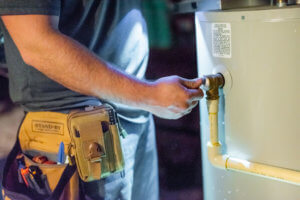Temperature pressure relief valves are there to protect the unit from building up to much pressure and blowing through the roof. The valve is usually rated for 150 psi and 210°F. If the tank ever exceeds these limits the spring valve will open allowing dangerously hot pressurized water to exit the unit. This can occurs due to the temperature on the water heater being set too high.
 This brings us to the next topic; the drainage line. The drainage line is what home inspectors write up all the time, we see all sorts of plumbing configurations that are D-Boxes. The line should be plumbed with a downhill slope allowing water to exit the home and not sit in the pipe. When the pipe is at the termination location it should be no more than 6 inches from grade with a 90º fitting directed towards the ground. This will ensure that scolding hot water will not injure anyone at the business end of the line. Home inspectors are required to look at these valves but sometimes we can’t check them for proper operation due to being above a living space of an occupied home or there is no known termination location. But if we know where the line terminates inspectors will usually open the valve for a slipt second and make sure it reseats. This is something that the homeowner should do annually to ensure the valve is always operable. If the valve is hard to open, does not reseat, shows signs of corrosion or there is water dripping from the line at termination you need to install a new TPR. Which is pretty easy for anyone that is comfortable performing a small plumbing job and has the appropriate tools. The valve is less than 20 bucks so it shouldn’t break the bank, but if you let it ride and the tank builds up to much pressure that roofing/plumbing job will cost you some dough.
This brings us to the next topic; the drainage line. The drainage line is what home inspectors write up all the time, we see all sorts of plumbing configurations that are D-Boxes. The line should be plumbed with a downhill slope allowing water to exit the home and not sit in the pipe. When the pipe is at the termination location it should be no more than 6 inches from grade with a 90º fitting directed towards the ground. This will ensure that scolding hot water will not injure anyone at the business end of the line. Home inspectors are required to look at these valves but sometimes we can’t check them for proper operation due to being above a living space of an occupied home or there is no known termination location. But if we know where the line terminates inspectors will usually open the valve for a slipt second and make sure it reseats. This is something that the homeowner should do annually to ensure the valve is always operable. If the valve is hard to open, does not reseat, shows signs of corrosion or there is water dripping from the line at termination you need to install a new TPR. Which is pretty easy for anyone that is comfortable performing a small plumbing job and has the appropriate tools. The valve is less than 20 bucks so it shouldn’t break the bank, but if you let it ride and the tank builds up to much pressure that roofing/plumbing job will cost you some dough.

